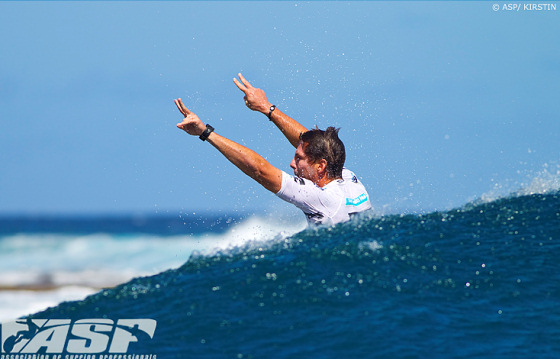Andy Irons died a natural death from a sudden cardiac arrest due to a severe blockage of a main artery of the heart.
This is the official final autopsy and toxicology report from the Tarrant County District Attorney's Office in Forth Worth, Texas. The surfer's family released the information and explained what happened in the past months through an official statement.
"This is a very straightforward case. Mr. Irons died of a heart attack due to focal severe coronary atherosclerosis, i.e., ‘hardening of the arteries.' He had an atherosclerotic plaque producing 70%-80% narrowing of his anterior descending coronary artery," reveals Dr. Vincent Di Maio, a prominent forensic pathologist consulted by the Andy Irons family.
"This is very severe narrowing. A plaque of this severity, located in the anterior descending coronary artery, is commonly associated with sudden death."
"The only unusual aspect of the case is Mr. Irons' age, 32 years old. Deaths due to coronary atherosclerosis usually begin to appear in the late 40's. Individuals such as Mr. Irons have a genetic predisposition to early development of coronary artery disease. In about 25% of the population, the first symptom of severe coronary atherosclerosis is sudden death. There were no other factors contributing to the death", he continues.
Andy had a grandmother, 77, and a grand-uncle, 51, both on his father's side, who died of congestive heart failure.
Looking back, Lyndie recalls that Andy complained of chest pains and occasional intense heartburn for the first time last year and also recalls a holistic health practitioner, whom he sought out in Australia for vitamin therapy, offhandedly mentioning he "had the heart of a 50-year-old."
In addition, Andy contracted Typhoid Fever five years ago, which can result in damage to the heart muscle.
The official autopsy report, prepared by Tarrant County Chief Medical Examiner Nizam Peerwani, MD, lists a second cause of death as "acute mixed drug ingestion."
On this point, Dr. Peerwani and Dr. Di Maio diverge. In a letter sent to Arch McColl, a Dallas-based attorney acting on behalf of the family, Dr. Di Maio questioned Dr. Peerwani's decision to list the finding "Acute Mixed Drug Ingestion" under "Cause of Death" because he believes "it was not the cause of death and did not contribute to the death. The Manner of Death is in fact labeled Natural."
Dr. Di Maio goes on to say that the drugs cited, Alprazolam (Xanax) and methadone (an analgesic drug commonly used in the treatment of chronic pain), are in "therapeutic levels" and notes that benzoylecgonine is an "inactive metabolite" which Gary H. Wimbish Ph.D., DABFT, a forensic toxicologist consulted by the family, has explained is a breakdown product of cocaine.
Wimbish states that the benzoylecgonine present in Andy's blood at 50 ng/ml "is consistent with the use of cocaine at about 30 hours prior to his death."
In addition, Wimbish agrees with Dr. Di Maio that the amount of Alprazolam present in Andy's blood "is consistent with a common therapeutic regimen."
Dr. Peerwani's report also cites the presence of a trace amount of methamphetamine.
Lyndie insists Andy was not a methamphetamine user, so it is likely the substance was present in the cocaine he ingested.
But again, Dr. Di Maio believes that none of these drugs was the cause of, or contributed to, Andy's death.
Irons Was Treating Anxiety and Insomnia
The family says, "Andy was prescribed Xanax and Zolpidem (Ambien) to treat anxiety and occasional insomnia - a result of a bipolar disorder diagnosed by his family doctor at age 18."
"This is when Andy first began experiencing episodes of manic highs and depressive lows."
"The family believes Andy was in some denial about the severity of his chemical imbalance and tended to blame his mood swings on himself and his own weaknesses, choosing to self-medicate with recreational drugs."
"Members of his family, close friends, and an industry sponsor intervened over the years to help Andy get clean, but the effort to find balance in his life was certainly complicated by his chemical makeup."
Finally, as has been reported, Andy was suffering from severe flu-like symptoms while in Puerto Rico to compete in the Rip Curl Pro Search leg of the ASP World Tour just days prior to his death.
Andy was unable to leave his bed and, for the first time in his professional career, withdrew from a contest.
He was put on an intravenous drip for hydration and strongly advised to seek further medical treatment.
Against the doctor's advice, Andy left for Kauai, Hawaii, to be with his wife, telling the doctor: "I just wanna go home."
Though Andy's illness is not addressed in the autopsy (which only tested for and ruled out suspected Dengue Fever), Andy's weakened condition clearly contributed to the tragic circumstances of his death, adding more stress to an already gravely compromised heart.
Having defied the odds so many times before, Andy may have felt that getting on a plane while dehydrated and wracked with fever, and choosing to meet up with acquaintances during a short layover in Miami, was nothing out of the ordinary.
His strong-willed personality was part of what made him such a formidable surfer and champion.
Like others who face down extreme danger, Andy seemed to feel bulletproof - as if nothing could take him down.
But traveling while sick and suffering from an undiagnosed heart condition was more than even Andy could overcome.
Andy Irons's memory will continue to be of an outstanding surfer, champion, friend, and husband. He will be greatly missed for what he has and could have done in life.
